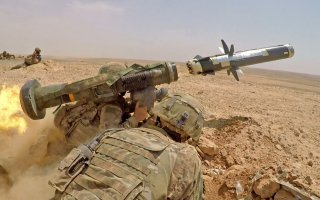U.S. Army Kills Drone with Stinger Missile Shot from Javelin System
The Stinger missile has a long history of hitting enemy helicopters and airborne threats.
Here's What You Need to Know: Combining both powerful Javelin and Stinger systems is creating a potent anti-drone defense.
A recent feat shows how networking threat-detecting radar technologies can help win on the battlefield. Army ground gunners recently destroyed a drone target with a Stinger missile fired from a new Raytheon-built sensor-targeting unit. One of the impressive things is that the sensor-targeting unit was initially designed for the Javelin anti-tank weapon, not the Stinger.
The Stinger missile, which has a long history of hitting enemy helicopters and airborne threats, was shot out of the Javelin’s Lightweight Command Launch Unit (LWCLU) at Eglin Air Force Base, bringing new tactical dimensions to ground-based drone defense. It was a first, as it introduces the ability to leverage the new sensor, range and targeting technologies built into the LWCLU.
The development introduces new possibilities for both the Stinger and the launcher, given that when firing the Javelin the LWCLU actually doubles the range from 2.5km to 4.5km and increases ground mobility restraints for soldiers because it is 30 percent lighter than its predecessor. The LWCLU brings increased sensor fidelity and targeting image resolution as well as a “fast lock” technology for improving attacks on the move, Raytheon weapons developers told The National Interest. The improved sensor performance also helps bring an surveillance and reconnaissance targeting component to dismounted ground war by, as a Raytheon statement explained it, “Offering twice the sight range at night and three times the site range during the day, regardless of weather conditions.”
“You have to be able to speed up the kill chain, and detect the adversary before he can detect you. You want to get a launch shot off before he knows you are there. It all starts with sensing,” Tommy Boccardi, Javelin Domestic Business Development, Raytheon, told The National Interest in October of last year.
Using advanced symbology for at-range targeting, the CLU enables “slew-to-cue” attack using integrated sensing and advanced optics.
“The CLU sensor has a constant zoom so you don’t have to flip from a wide field of view to a narrow field of view. That is all done inside the sensors for you - precision targeting the entire time,” he said.
Longer range, more precise targeting also helps sustain doctrinal requirements for the Army, as enables more precise target identification to ensure the proper targets are hit.
“Our doctrine is we visually ID before we shoot. In this case you have an electronic sensor providing targeting data to the gunner,” Boccardi said.
All of these nuances, proven to be of critical importance to the Javelin’s adaptation of the LWCLU, are now applicable to counter-drone attacks for dismounted soldiers. An ability to hit targets at longer ranges naturally expands the kinds of targets a Stinger missile is able to hit, such as drones. The Stinger, which Raytheon data says has achieved more than 270 fixed and rotary-wing intercepts, will now be able to hit higher-flying drones and other targets previously not reachable.
A Stinger-armed infantry force can add a useful attack option to complement the existing armored vehicle-mounted Short Range Air Defense program which now deploys Stryker vehicles armed with Hellfire, Javelin and Stinger missiles for counter air missions. Now, small groups of dismounted infantry units on the move in combat, potentially operating further forward with less mechanized support, will have a much stronger sphere of defenses against enemy drones.
Kris Osborn is the defense editor for the National Interest. Osborn previously served at the Pentagon as a Highly Qualified Expert with the Office of the Assistant Secretary of the Army—Acquisition, Logistics & Technology. Osborn has also worked as an anchor and on-air military specialist at national TV networks. He has appeared as a guest military expert on Fox News, MSNBC, The Military Channel, and The History Channel. He also has a Masters Degree in Comparative Literature from Columbia University.
This article first appeared in March 2021.
Image: U.S. Army photo by Sgt. Liane Hatch

